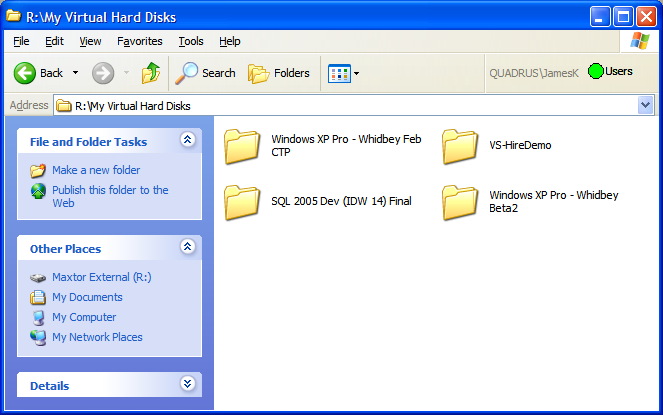Scott Hanselman has done it again. Go check out the goodness that is
Scott Hanselman’s 2005 Ultimate Developer and Power Users Tool List
The list is getting insanely long, but there is some insanely good stuff in there.
Scott Hanselman has done it again. Go check out the goodness that is
Scott Hanselman’s 2005 Ultimate Developer and Power Users Tool List
The list is getting insanely long, but there is some insanely good stuff in there.
Back when I was using BSD Unix and Linux a lot, sym links were incredibly handy creatures. It was with great joy that I recently discovered NTFS Junctions (aka Reparse Points), which are directory-only sym links for NTFS file systems. Junctions are supported in NTFS on Windows 2000, Windows XP, and Windows 2003 Server. Out-of-the-box, Junctions are not easy to use, but two little utilities make life much easier:
Now you might be wondering, what the heck are sym links/junctions/reparse points and why should I care? Let’s take my current setup as an example. I’ve got a pile of virtual machines for running the latest Visual Studio 2005 and SQL Server 2005 bits, along with installs for Indigo, Avalon, and WinFX. My laptop hard drive, while a spacious 60 GB, fills up rather quickly with all those VHD files. Now I could put all the VHDs on my 300 GB Maxtor external drive, but what happens when I need to use one on the road. (The Maxtor external drive requires an external power supply. So you can’t fire it up when you’re commuting on the bus.) I could copy it over to the internal drive, but then I have to tidy up my delete/re-create the virtual machine in the VPC 2004 console. Instead I junction the virtual machine directory on my external drive to “My Documents\My Virtual Machines”. Here is my external drive:

Here is My Documents\My Virtual Machines:

The little links on the folders come from the Junction Icon Overlay.
When I want to create a new virtual machine on the external drive, for example Windows XP Pro – Whidbey RC1:
This has a number of advantages over just creating the virtual machine on the external drive:
There are lots of other uses of junctions. Scott Hanselman’s favourite seems to be avoiding “the evil that is the Company-Wide Subst” when creating a standard development build tree. (Very good use, I must say.) You could also use them to archive old C:\Program Files without having to uninstall/re-install the programs – simply move the directory to your external drive and create a junction from C:\Program Files to the new location. Use your imagination and you’ll be amazed at the uses you can put these little critters to. You’ll also wonder how you ever lived without them.
Kit George, Joe Duffy, and Steve Herndon of the .NET Framework BCL Team are coming to Calgary to talk about CLR 2.0. Way cool! The chat is being hosted by the Alberta .NET User Group. Sign up there.
Very humourous cartoon. I suspect that the intersection between fans of blogging and Star Trek is a very large group. Enjoy!
This is a great whitepaper by M.K. Park of the Visual CSharp Debugger QA team. Whenever I run into Visual Studio debugger problems, I’ll reference it. It’s been around for awhile, but I’m posting the link so I can find it more easily in the future. Blogs are great for increasing your long-term storage capacity.